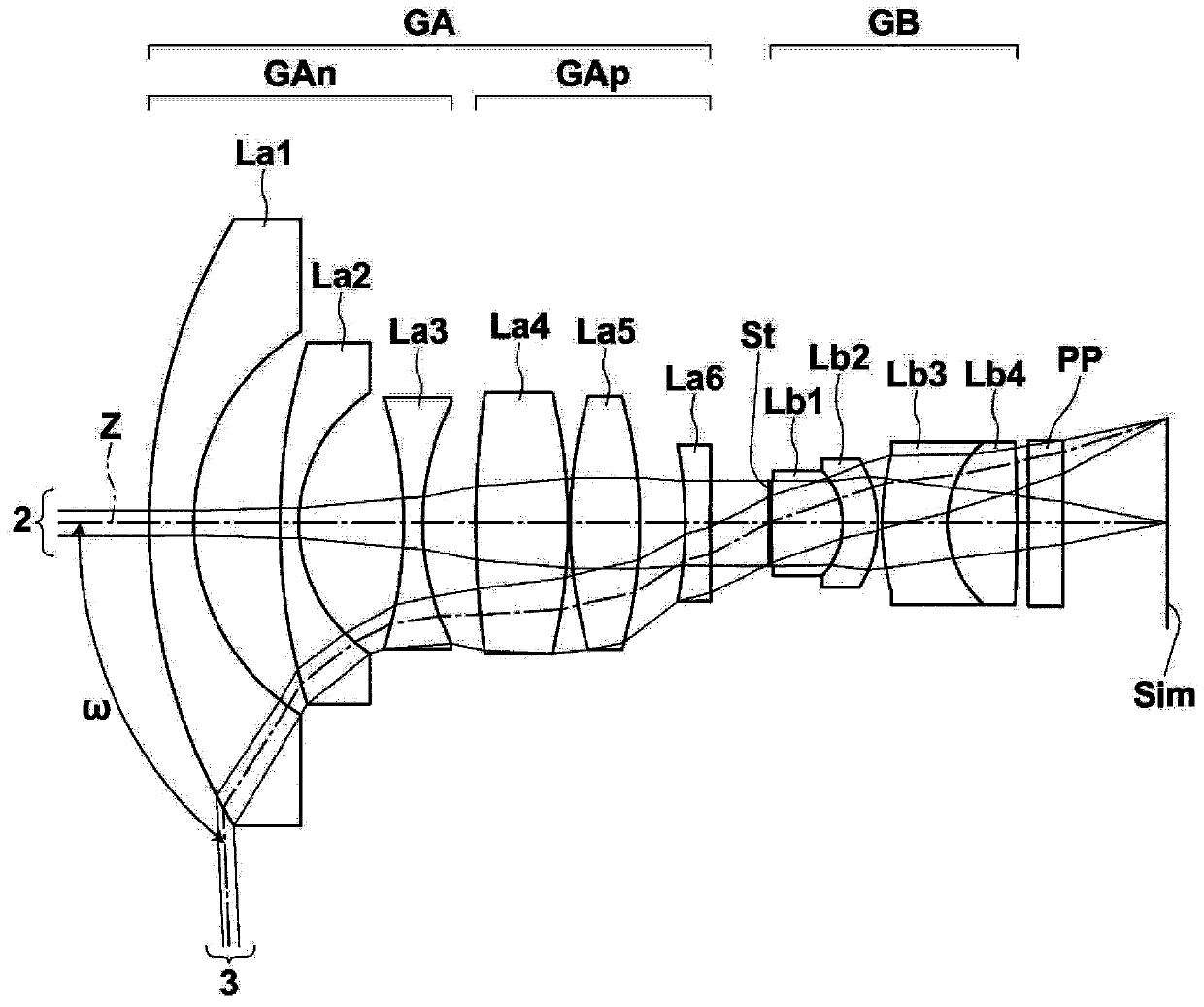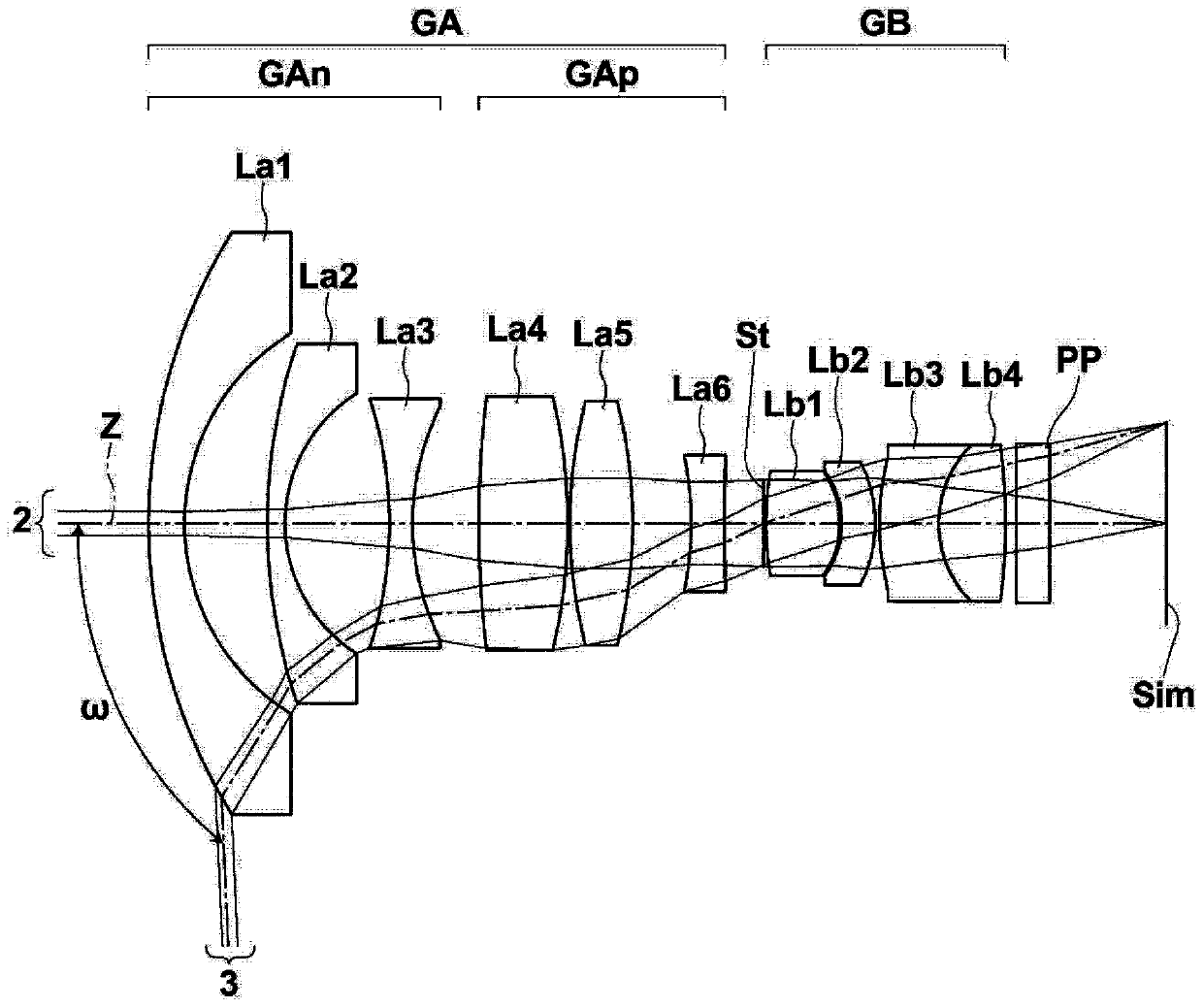Camera lens and camera device
A camera lens, lens technology, applied in optical components, instruments, optics, etc., can solve the problem of small F value of the lens system, and achieve the effect of small F value, high optical performance, and wide field of view.
- Summary
- Abstract
- Description
- Claims
- Application Information
AI Technical Summary
Problems solved by technology
Method used
Image
Examples
Embodiment 1
[0122] The structure of the imaging lens of embodiment 1 is as follows figure 1 shown. It should be noted, figure 1 The detailed description of each lens group and each lens in the structure is as above, so repeated description is omitted here.
[0123] Table 1 shows the lens data of the imaging lens of Example 1. The Si column of Table 1 shows the i-th (i=1, 2, 3, ...) surface numbers that increase sequentially toward the image side, with the object-side surface of the most object-side component as the first , the Ri column shows the radius of curvature of the i-th surface, and the Di column shows the distance between the i-th surface and the i+1-th surface on the optical axis Z. It should be noted that the sign of the radius of curvature is positive in the case of a surface shape with a convex surface facing the object side, and negative in the case of a surface shape with a convex surface facing the image side. The value in the lowermost column of Di is the distance bet...
Embodiment 2
[0133] The structure of the imaging lens of embodiment 2 is as follows figure 2 shown. In the imaging lens of Example 2, the front negative lens group GAn is composed of lenses La1 to La3, the front positive lens group GAp is composed of lenses La4 to La7, and the rear group GB is composed of lenses Lb1 to Lb4. Table 2 shows the lens data of the imaging lens of Example 2. Figure 7 Each aberration diagram in the state where the imaging lens of Example 2 is in focus on an object at infinity is shown in .
[0134] 【Table 2】
[0135] Example 2
[0136] f=1.00, Bf=2.26, FNo.=2.55, 2ω=185.0°
[0137] Si Ri Di Ndj νdj ΔθgFj 1 9.1047 0.7055 1.90366 31.31 0.00391 2 3.4197 1.3197 3 9.2525 0.2864 1.85026 32.27 0.00364 4 2.3784 1.5137 5 -8.5657 0.2863 1.61800 63.33 0.00509 6 4.0610 0.5243 7 22.9665 0.9248 1.51633 64.14 -0.00239 8 11.2072 0.9183 1.84666 23.78 0.01751 9 -11.0359 ...
Embodiment 3
[0139] The structure of the imaging lens of embodiment 3 is as image 3 shown. In the imaging lens of Example 3, the front negative lens group GAn is composed of lenses La1 to La3, the front positive lens group GAp is composed of lenses La4 to La6, and the rear group GB is composed of lenses Lb1 to Lb4. Table 3 shows the lens data of the imaging lens of Example 3. Figure 8 Each aberration diagram in the state where the imaging lens of Example 3 is in focus on an object at infinity is shown in .
[0140] 【table 3】
[0141] Example 3
[0142] f=1.00, Bf=2.41, FNo.=2.55, 2ω=185.0°
[0143] Si Ri Di Ndj νdj ΔθgFj 1 8.7150 0.5788 1.90366 31.31 0.00391 2 3.5608 1.3343 3 8.8901 0.2861 1.85026 32.27 0.00364 4 2.4650 1.6807 5 -6.3968 0.3710 1.61800 63.33 0.00509 6 4.1489 1.0731 7 16.2728 1.4308 1.80518 25.42 0.01576 8 -8.7085 0.0361 9 7.6986 1.0062 1.80610 40.93 -0.0051...
PUM
 Login to View More
Login to View More Abstract
Description
Claims
Application Information
 Login to View More
Login to View More - R&D
- Intellectual Property
- Life Sciences
- Materials
- Tech Scout
- Unparalleled Data Quality
- Higher Quality Content
- 60% Fewer Hallucinations
Browse by: Latest US Patents, China's latest patents, Technical Efficacy Thesaurus, Application Domain, Technology Topic, Popular Technical Reports.
© 2025 PatSnap. All rights reserved.Legal|Privacy policy|Modern Slavery Act Transparency Statement|Sitemap|About US| Contact US: help@patsnap.com



